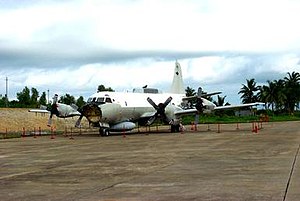| Hainan Island incident | |||||||
|---|---|---|---|---|---|---|---|
 The damaged EP-3 on the ground on Hainan Island. | |||||||
| |||||||
| Belligerents | |||||||
|
|
| ||||||
| Commanders and leaders | |||||||
|
| ||||||
| Strength | |||||||
| 1 EP-3E signals intelligence aircraft | 2 Shenyang J-8II aircraft | ||||||
| Casualties and losses | |||||||
|
| ||||||
The Hainan Island incident was a ten-day international incident between the United States and the People's Republic of China (PRC) that resulted from a mid-air collision between a United States Navy EP-3E ARIES II signals intelligence aircraft and a Chinese Air Force J-8 interceptor on April 1, 2001.
The EP-3 was flying over the South China sea at a point roughly midway between Hainan Island and the Paracel Islands when it was intercepted by two J-8II fighters. A collision between the EP-3 and one of the J-8s caused damage to the EP-3 and the loss of the J-8 and its pilot. The EP-3 was forced to make an emergency landing on Hainan without permission from the PRC, and its 24 crew members were detained and interrogated by Chinese authorities until a statement was delivered by the United States government regarding the incident. The ambiguous phrasing of the statement allowed both countries to save face and defused a potentially volatile situation.[1][2]
- ^ Tapper, Jake; Lindsey, Daryl; Montgomery, Alicia (April 13, 2001). "War of words". Salon. Archived from the original on August 6, 2022. Retrieved September 28, 2010.
- ^ Zhang, Hang (2001). "Culture and apology: The Hainan Island incident". World Englishes. 20 (3): 383–391. doi:10.1111/1467-971X.00222.